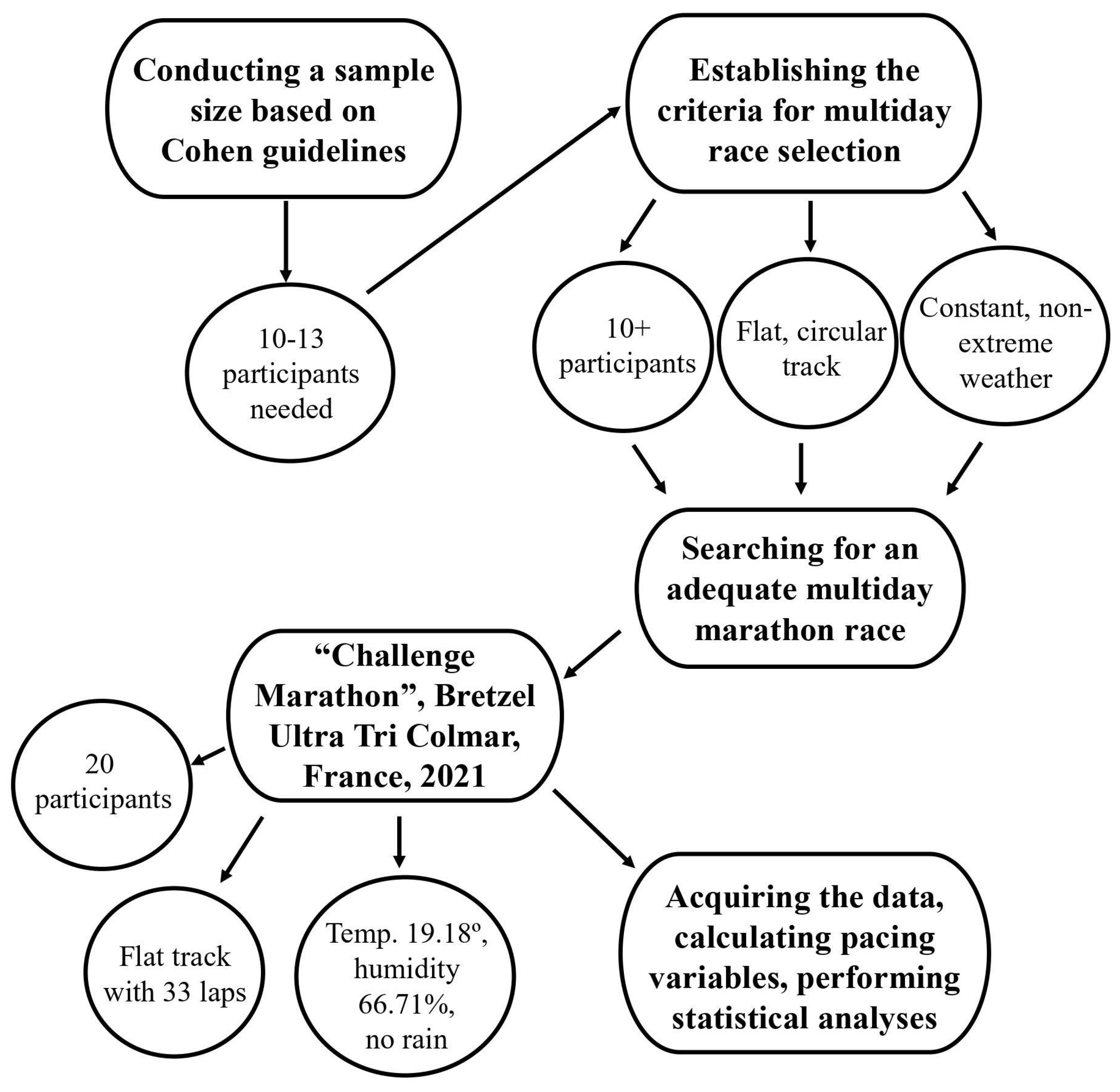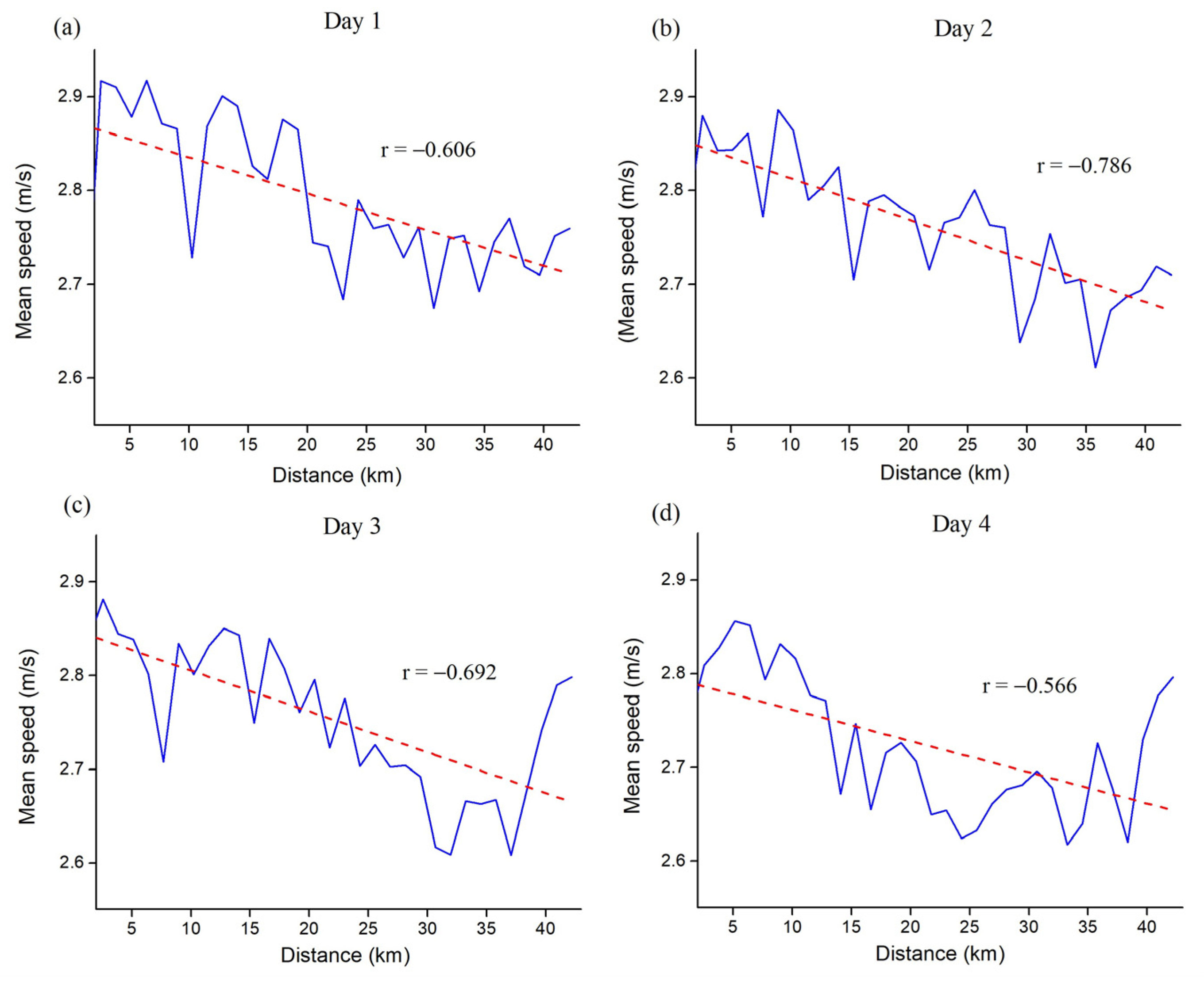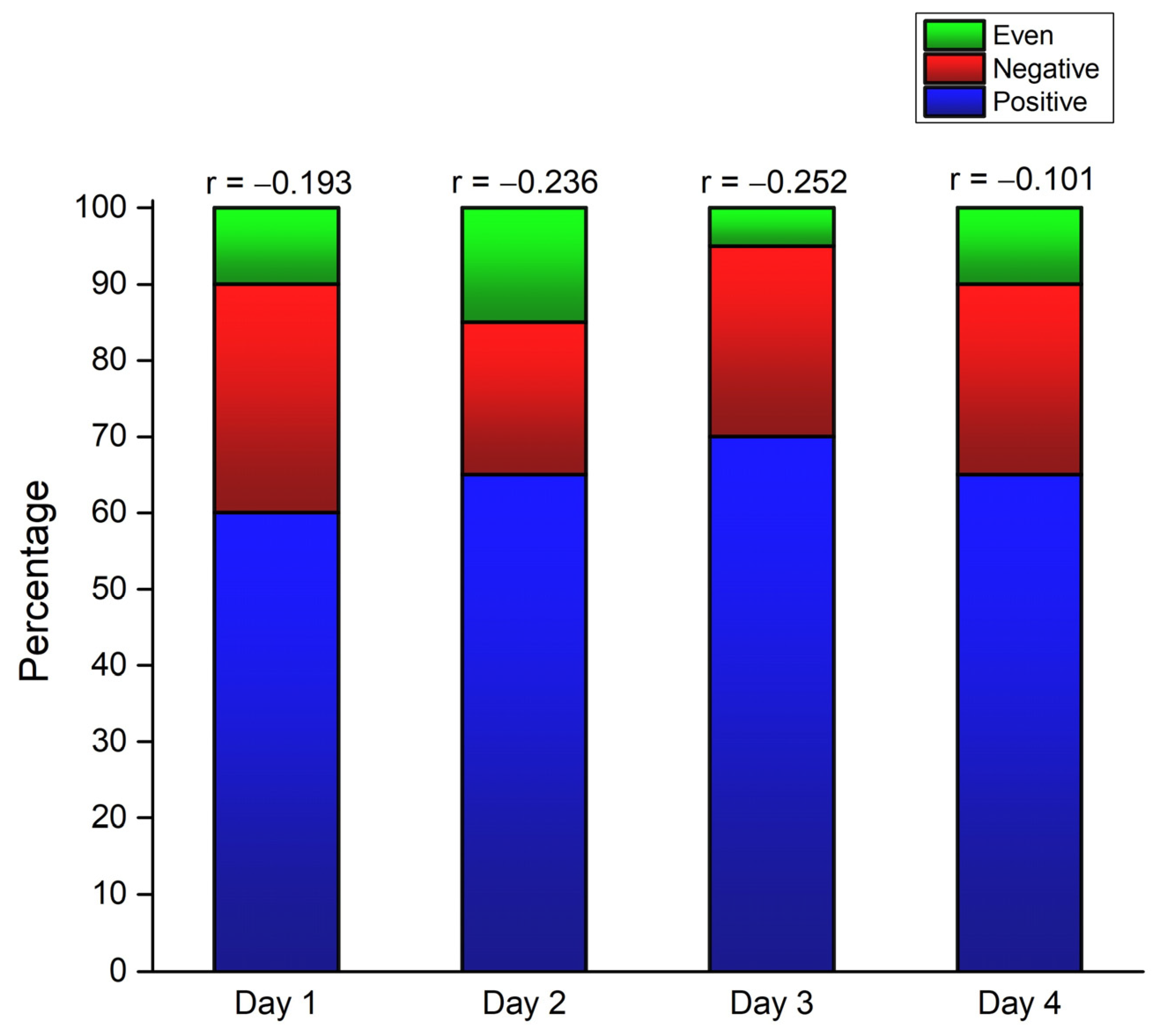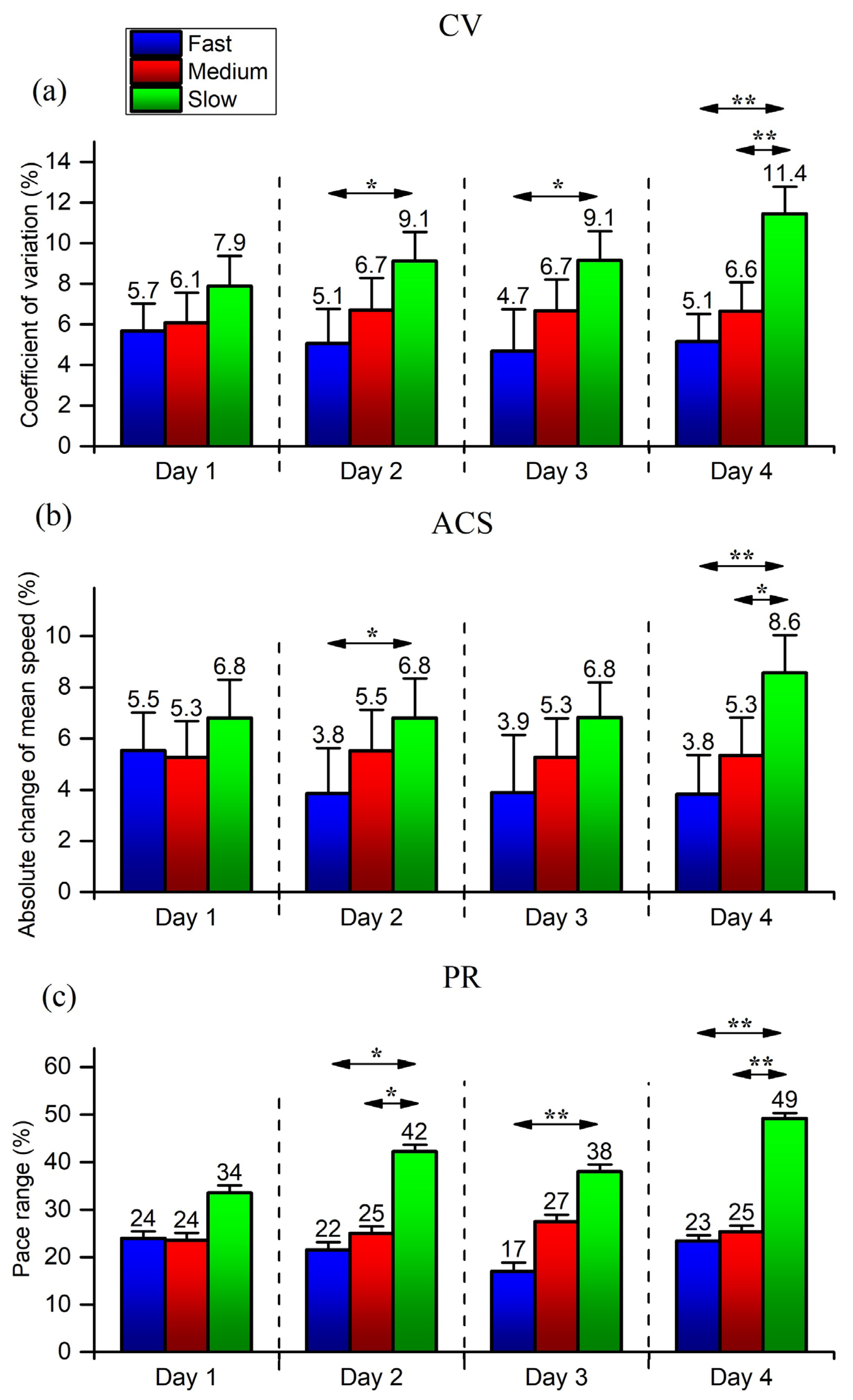Running Variability in Marathon—Evaluation of the Pacing Variables
Abstract
:1. Introduction
2. Materials and Methods
2.1. Ethical Approval
2.2. Participants
2.3. The Race
2.4. Data Analysis
2.4.1. Dependent Variables
- Mean speed (MS). The MS for each lap and the MS for each marathon race were calculated based on the time needed to complete the distance.
- Pace range (PR). The fastest and slowest lap MS were identified. These laps were then expressed as a percentage faster or slower than the race MS. Each individual’s fastest lap MS was named “positive range”, while the slowest lap MS was called “negative range”. The absolute sum of the positive and negative ranges was calculated to obtain PR [23,40].
- First 32-10 split (32-10). The 32-10 split was calculated as a percentage of MS change in the last 10 km in relation to the MS of the prior 32 km of the race [17].
2.4.2. Independent Variable
2.5. Statistical Analysis
3. Results
3.1. Day-to-Day Running Variability
3.2. Reliability and Validity of the Pacing Variables
3.3. Sensitivity of the Pacing Variables
4. Discussion
4.1. Running Variability
4.2. Reliability and Validity of the Pacing Variables
4.3. Sensitivity of the Pacing Variables
4.4. Limitations
5. Conclusions
Practical Applications
Author Contributions
Funding
Institutional Review Board Statement
Informed Consent Statement
Data Availability Statement
Conflicts of Interest
References
- Foster, C.; De Koning, J.J.; Hettinga, F.; Lampen, J.; La Clair, K.L.; Dodge, C.; Bobbert, M.; Porcari, J.P. Pattern of energy expenditure during simulated competition. Med. Sci. Sports Exerc. 2003, 35, 826–831. [Google Scholar] [CrossRef]
- Smits, B.L.M.; Pepping, G.-J.; Hettinga, F.J. Pacing and Decision Making in Sport and Exercise: The Roles of Perception and Action in the Regulation of Exercise Intensity. Sports Med. 2014, 44, 763–775. [Google Scholar] [CrossRef] [PubMed]
- Hanley, B. Pacing, packing and sex-based differences in Olympic and IAAF World Championship marathons. J. Sports Sci. 2016, 34, 1675–1681. [Google Scholar] [CrossRef]
- Hettinga, F.J.; Konings, M.J.; Pepping, G.J. The science of racing against opponents: Affordance competition and the regulation of exercise intensity in head-to-head competition. Front. Physiol. 2017, 8, 118. [Google Scholar] [CrossRef]
- Konings, M.J.; Hettinga, F.J. Objectifying tactics: Athlete and race variability in elite short-track speed skating. Int. J. Sports Physiol. Perform. 2018, 13, 170–175. [Google Scholar] [CrossRef]
- Konings, M.J.; Schoenmakers, P.P.J.M.; Walker, A.J.; Hettinga, F.J. The behavior of an opponent alters pacing decisions in 4-km cycling time trials. Physiol. Behav. 2016, 158, 1–5. [Google Scholar] [CrossRef]
- Cuk, I.; Nikolaidis, P.T.; Villiger, E.; Knechtle, B. Pacing in Long-Distance Running: Sex and Age Differences in 10-km Race and Marathon. Medicina 2021, 57, 389. [Google Scholar] [CrossRef]
- Abbiss, C.R.; Laursen, P.B. Describing and understanding pacing strategies during athletic competition. Sports Med. 2008, 38, 239–252. [Google Scholar] [CrossRef] [PubMed]
- Tucker, R.; Noakes, T.D. The physiological regulation of pacing strategy during exercise: A critical review. Br. J. Sports Med. 2009, 43, e1. [Google Scholar] [CrossRef]
- Foster, C.; Dekoning, J.J.; Hettinga, F.; Lampen, J.; Dodge, C.; Bobbert, M.; Porcari, J.P. Effect of competitive distance on energy expenditure during simulated competition. Int. J. Sports Med. 2004, 25, 198–204. [Google Scholar] [CrossRef] [PubMed]
- Tucker, R.; Lambert, M.I.; Noakes, T.D. An analysis of pacing strategies during men’s world-record performances in track athletics. Int. J. Sports Physiol. Perform. 2006, 1, 233–245. [Google Scholar] [CrossRef]
- De Koning, J.J.; Foster, C.; Bakkum, A.; Kloppenburg, S.; Thiel, C.; Joseph, T.; Cohen, J.; Porcari, J.P. Regulation of pacing strategy during athletic competition. PLoS ONE 2011, 6, e15863. [Google Scholar] [CrossRef] [PubMed]
- Fukuba, Y.; Whipp, B.J. A metabolic limit on the ability to make up for lost time in endurance events. J. Appl. Physiol. 1999, 87, 853–861. [Google Scholar] [CrossRef]
- Zamparo, P.; Bonifazi, M.; Faina, M.; Milan, A.; Sardella, F.; Schena, F.; Capelli, C. Energy cost of swimming of elite long-distance swimmers. Eur. J. Appl. Physiol. 2005, 94, 697–704. [Google Scholar] [CrossRef]
- Hader, K.; Mendez-Villanueva, A.; Palazzi, D.; Ahmaidi, S.; Buchheit, M. Metabolic power requirement of change of direction speed in young soccer players: Not all is what it seems. PLoS ONE 2016, 11, e0149839. [Google Scholar] [CrossRef]
- Verheul, J.; Nedergaard, N.J.; Pogson, M.; Lisboa, P.; Gregson, W.; Vanrenterghem, J.; Robinson, M.A. Biomechanical loading during running: Can a two mass-spring-damper model be used to evaluate ground reaction forces for high-intensity tasks? Sports Biomech. 2021, 20, 571–582. [Google Scholar] [CrossRef]
- March, D.S.; Vanderburgh, P.M.; Titlebaum, P.J.; Hoops, M.L. Age, sex, and finish time as determinants of pacing in the marathon. J. Strength Cond. Res. 2011, 25, 386–391. [Google Scholar] [CrossRef] [PubMed]
- Cuk, I.; Nikolaidis, P.T.; Knechtle, B. Sex differences in pacing during half-marathon and marathon race. Res. Sports Med. 2020, 28, 111–120. [Google Scholar] [CrossRef]
- Knechtle, B.; Cuk, I.; Villiger, E.; Nikolaidis, P.T.; Weiss, K.; Scheer, V.; Thuany, M. The Effects of Sex, Age and Performance Level on Pacing in Ultra-Marathon Runners in the ‘Spartathlon’. Sports Med. Open 2022, 8, 69. [Google Scholar] [CrossRef]
- Santos-Lozano, A.; Collado, P.S.; Foster, C.; Lucia, A.; Garatachea, N. Influence of Sex and Level on Marathon Pacing Strategy. Insights from the New York City Race. Int. J. Sports Med. 2014, 35, 933–938. [Google Scholar] [CrossRef] [PubMed]
- De Leeuw, A.W.; Meerhoff, L.A.; Knobbe, A. Effects of pacing properties on performance in long-distance running. Big Data 2018, 6, 248–261. [Google Scholar] [CrossRef]
- Deusch, H.; Nikolaidis, P.T.; Alvero-Cruz, J.R.; Rosemann, T.; Knechtle, B. Pacing in time-limited ultramarathons from 6 to 24 hours—The aspects of age, sex and performance level. Sustainability 2021, 13, 2705. [Google Scholar] [CrossRef]
- Breen, D.; Norris, M.; Healy, R.; Anderson, R. Marathon pace control in masters athletes. Int. J. Sports Physiol. Perform. 2018, 13, 332–338. [Google Scholar] [CrossRef]
- Lima-Silva, A.E.; Bertuzzi, R.C.; Pires, F.O.; Barros, R.V.; Gagliardi, J.F.; Hammond, J.; Kiss, M.A.; Bishop, D.J. Effect of performance level on pacing strategy during a 10-km running race. Eur. J. Appl. Physiol. 2010, 108, 1045–1053. [Google Scholar] [CrossRef]
- Nikolaidis, P.T.; Cuk, I.; Clemente-suárez, V.J.; Villiger, E.; Knechtle, B. Number of finishers and performance of age group women and men in long-distance running: Comparison among 10km, half-marathon and marathon races in Oslo. Res. Sports Med. 2020, 29, 55–56. [Google Scholar] [CrossRef] [PubMed]
- Sealey, R.M.; Spinks, W.L.; Leicht, A.S.; Sinclair, W.H. Identification and reliability of pacing strategies in outrigger canoeing ergometry. J. Sci. Med. Sport 2010, 13, 241–246. [Google Scholar] [CrossRef]
- Skorski, S.; Faude, O.; Caviezel, S.; Meyer, T. Reproducibility of pacing profiles in elite swimmers. Int. J. Sports Physiol. Perform. 2014, 9, 217–225. [Google Scholar] [CrossRef]
- Lipinska, P.; Allen, S.V.; Hopkins, W.G. Relationships between pacing parameters and performance of elite male 1500-m swimmers. Int. J. Sports Physiol. Perform. 2016, 11, 159–163. [Google Scholar] [CrossRef]
- Lipińska, P.; Allen, S.V.; Hopkins, W.G. Modeling parameters that characterize pacing of elite female 800-m freestyle swimmers. Eur. J. Sport. Sci. 2016, 16, 287–292. [Google Scholar] [CrossRef]
- Thomas, K.; Stone, M.R.; Thompson, K.G.; St Clair Gibson, A.; Ansley, L. Reproducibility of pacing strategy during simulated 20-km cycling time trials in well-trained cyclists. Eur. J. Appl. Physiol. 2012, 112, 223–229. [Google Scholar] [CrossRef]
- Azevedo, R.; Cruz, R.; Silva-Cavalcante, M.; Silva, R.; Correia-Oliveira, C.; Couto, P.; Lima-Silva, A.; Bertuzzi, R. Methodological approaches to determine the “U”-pacing strategy in cycling time trial. Int. J. Perform. Anal. Sport 2017, 17, 752–762. [Google Scholar] [CrossRef]
- Watkins, J.; Platt, S.; Andersson, E.; McGawley, K. Pacing strategies and metabolic responses during 4-Minute running time trials. Int. J. Sports Physiol. Perform. 2017, 12, 1143–1150. [Google Scholar] [CrossRef]
- Chlíbková, D.; Nikolaidis, P.T.; Rosemann, T.; Knechtle, B.; Bednář, J. Fluid Metabolism in Athletes Running Seven Marathons in Seven Consecutive Days. Front. Physiol. 2018, 9, 91. [Google Scholar] [CrossRef]
- Klenk, C.; Brunner, H.; Nickel, T.; Sagmeister, F.; Yilmaz, A.; Infanger, D.; Billich, C.; Scharhag, J.; Vogeser, M.; Beer, M.; et al. Cardiac structure and function in response to a multi-stage marathon over 4486 km. Eur. J. Prev. Cardiol. 2021, 28, 1102–1109. [Google Scholar] [CrossRef]
- Cohen, J. Statistical Power Analysis for the Behavioral Sciences; Routledge: London, UK, 2013. [Google Scholar]
- Díaz, J.J.; Fernández-Ozcorta, E.J.; Santos-Concejero, J. The influence of pacing strategy on marathon world records. Eur. J. Sport Sci. 2018, 18, 781–786. [Google Scholar] [CrossRef]
- Haney, T.A.; Mercer, J.A. A Description of Variability of Pacing in Marathon Distance Running. Int. J. Exerc. Sci. 2011, 4, 133–140. [Google Scholar]
- Hettinga, F.J.; Edwards, A.M.; Hanley, B. The Science Behind Competition and Winning in Athletics: Using World-Level Competition Data to Explore Pacing and Tactics. Front. Sports Act. Living 2019, 1, 11. [Google Scholar] [CrossRef]
- Chatzakis, P.; Paradisis, G.; Chryssanthopoulos, C.; Zacharogiannis, E. Effect of performance standard and sex on 24 h ultra-marathon pacing profiles. J. Sports Anal. 2021, 7, 247–253. [Google Scholar] [CrossRef]
- Cuk, I.; Nikolaidis, P.T.; Markovic, S.; Knechtle, B. Age differences in pacing in endurance running: Comparison between marathon and half-marathon Men and Women. Medicina 2019, 55, 479. [Google Scholar] [CrossRef]
- Deaner, R.O.; Carter, R.E.; Joyner, M.J.; Hunter, S.K. Men are more likely than women to slow in the marathon. Med. Sci. Sports Exerc. 2014, 47, 607–616. [Google Scholar] [CrossRef]
- Kais, Ü.; Mooses, K.; Pind, R.; Pehme, A.; Kaasik, P.; Mooses, M. Pacing strategy of the finishers of the world marathon majors series. Kinesiology 2019, 51, 22–27. [Google Scholar] [CrossRef]
- Silver, N.C.; Dunlap, W.P. Averaging correlation coefficients: Should Fisher’s z transformation be used? J. Appl. Psychol. 1987, 72, 146. [Google Scholar] [CrossRef]
- Stewart, A.M.; Hopkins, W.G. Seasonal training and performance of competitive swimmers. J. Sports Sci. 2000, 18, 873–884. [Google Scholar] [CrossRef]
- Hopkins, W.G. Measures of Reliability in Sports Medicine and Science. Sports Med. 2000, 30, 1–15. [Google Scholar] [CrossRef]
- Koo, T.K.; Li, M.Y. A Guideline of Selecting and Reporting Intraclass Correlation Coefficients for Reliability Research. J. Chiropr. Med. 2016, 15, 155–163. [Google Scholar] [CrossRef]
- Elferink-Gemser, M.T.; Hettinga, F.J. Pacing and self-regulation: Important skills for talent development in endurance sports. Int. J. Sports Physiol. Perform. 2017, 12, 831–835. [Google Scholar] [CrossRef]
- Van Biesen, D.; Hettinga, F.J.; McCulloch, K.; Vanlandewijck, Y. Pacing profiles in competitive track races: Regulation of exercise intensity is related to cognitive ability. Front. Physiol. 2016, 7, 624. [Google Scholar] [CrossRef]
- Van Biesen, D.; Hettinga, F.J.; McCulloch, K.; Vanlandewijck, Y.C. Pacing Ability in Elite Runners with Intellectual Impairment. Med. Sci. Sports Exerc. 2017, 49, 588–594. [Google Scholar] [CrossRef] [PubMed]
- Ely, M.R.; Martin, D.E.; Cheuvront, S.N.; Montain, S.J. Effect of ambient temperature on marathon pacing is dependent on runner ability. Med. Sci. Sports Exerc. 2008, 40, 1675–1680. [Google Scholar] [CrossRef]




| Variable | Day 1 | Day 2 | Day 3 | Day 4 | CV% | SEM | ICC (95% CI) | F | p |
|---|---|---|---|---|---|---|---|---|---|
| MS | 2.72 ± 0.32 | 2.74 ± 0.36 | 2.73 ± 0.36 | 2.69 ± 0.38 | 4.10 | 0.11 | 0.920 (0.862, 0.958) | 0.731 | 0.538 |
| CV | 6.50 ± 1.47 | 6.85 ± 1.64 | 6.68 ± 1.76 | 7.44 ± 1.58 | 23.22 | 1.26 | 0.785 (0.650, 0.884) | 1.244 | 0.302 |
| CS | 5.58 ± 2.30 | 4.27 ± 2.47 | 5.17 ± 2.76 | 3.52 ± 3.17 | 77.09 | 2.16 | 0.404 (0.190, 0.625) | 1.110 | 0.353 |
| CSF | 9.69 ± 1.61 | 7.49 ± 1.49 | 9.02 ± 1.99 | 7.46 ± 1.51 | 43.64 | 1.55 | 0.267 (0.06, 0.509) | 2.109 | 0.130 |
| ACS | 5.84 ± 1.47 | 5.32 ± 1.69 | 5.25 ± 1.76 | 5.69 ± 1.67 | 24.42 | 1.28 | 0.781 (0.645, 0.882) | 0.775 | 0.513 |
| PR | 26.78 ± 1.56 | 28.70 ± 1.65 | 26.62 ± 1.77 | 31.20 ± 1.51 | 26.10 | 1.30 | 0.732 (0.576, 0.853) | 1.721 | 0.173 |
| MRS | 4.05 ± 3.24 | 4.21 ± 4.10 | 6.32 ± 2.45 | 4.55 ± 2.01 | 93.84 | 2.56 | 0.258 (0.052, 0.501) | 0.864 | 0.465 |
| 32-10 | 5.45 ± 2.59 | 3.96 ± 2.94 | 4.87 ± 2.51 | 3.24 ± 3.57 | 82.54 | 2.28 | 0.418 (0.205, 0.637) | 1.112 | 0.342 |
| Variables (Day 1) | CV (Day 1) | Variables (Day 2) | CV (Day 2) | Variables (Day 3) | CV (Day 3) | Variables (Day 4) | CV (Day 4) | ||||
|---|---|---|---|---|---|---|---|---|---|---|---|
| r | p | r | p | r | p | r | p | ||||
| CS | 0.416 | 0.068 | CS | 0.093 | 0.695 | CS | 0.010 | 0.968 | CS | 0.323 | 0.165 |
| CSF | 0.317 | 0.173 | CSF | 0.664 ** | 0.001 | CSF | 0.712 ** | <0.001 | CSF | 0.828 ** | <0.001 |
| ACS | 0.926 ** | <0.001 | ACS | 0.982 ** | <0.001 | ACS | 0.980 ** | <0.001 | ACS | 0.977 ** | <0.001 |
| PR | 0.972 ** | <0.001 | PR | 0.924 ** | <0.001 | PR | 0.969 ** | <0.001 | PR | 0.908 ** | <0.001 |
| MRS | −0.193 | 0.415 | MRS | 0.389 | 0.090 | MRS | 0.418 | 0.067 | MRS | 0.657 ** | 0.002 |
| 32-10 | 0.396 | 0.084 | 32-10 | 0.090 | 0.706 | 32-10 | 0.039 | 0.870 | 32-10 | 0.314 | 0.178 |
| Variables (Day 1). | Mean Speed (Day 1) | Variables (Day 2) | Mean Speed (Day 2) | Variables (Day 3) | Mean Speed (Day 3) | Variables (Day 4) | Mean Speed (Day 4) | ||||
|---|---|---|---|---|---|---|---|---|---|---|---|
| r | p | r | p | r | p | r | p | ||||
| CV | −0.480 * | 0.032 | CV | −0.531 * | 0.016 | CV | −0.560 * | 0.010 | CV | −0.709 ** | <0.001 |
| ACS | −0.409 | 0.073 | ACS | −0.461 * | 0.041 | ACS | −0.479 * | 0.033 | ACS | −0.669 ** | 0.001 |
| PR | −0.520 * | 0.019 | PR | −0.632 ** | 0.003 | PR | −0.623 ** | 0.003 | PR | −0.670 ** | 0.001 |
Disclaimer/Publisher’s Note: The statements, opinions and data contained in all publications are solely those of the individual author(s) and contributor(s) and not of MDPI and/or the editor(s). MDPI and/or the editor(s) disclaim responsibility for any injury to people or property resulting from any ideas, methods, instructions or products referred to in the content. |
© 2024 by the authors. Licensee MDPI, Basel, Switzerland. This article is an open access article distributed under the terms and conditions of the Creative Commons Attribution (CC BY) license (https://creativecommons.org/licenses/by/4.0/).
Share and Cite
Cuk, I.; Markovic, S.; Weiss, K.; Knechtle, B. Running Variability in Marathon—Evaluation of the Pacing Variables. Medicina 2024, 60, 218. https://doi.org/10.3390/medicina60020218
Cuk I, Markovic S, Weiss K, Knechtle B. Running Variability in Marathon—Evaluation of the Pacing Variables. Medicina. 2024; 60(2):218. https://doi.org/10.3390/medicina60020218
Chicago/Turabian StyleCuk, Ivan, Srdjan Markovic, Katja Weiss, and Beat Knechtle. 2024. "Running Variability in Marathon—Evaluation of the Pacing Variables" Medicina 60, no. 2: 218. https://doi.org/10.3390/medicina60020218








